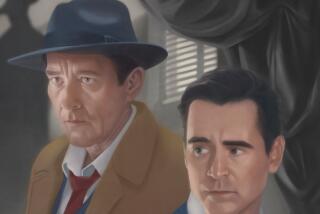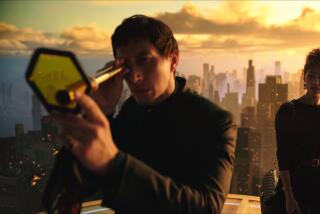Classic Hollywood: A dark ‘Great Gatsby’
Noir City: Hollywood, 14th Annual Festival of Film Noir opens Friday at the American Cinematheque’s Egyptian Theatre with a rare screening of the 1949 adaptation ofF. Scott Fitzgerald’s “The Great Gatsby.”
“The Great Gatsby”?
Rarely have the words film noir and “The Great Gatsby” been used in the same sentence. Fitzgerald’s 1925 masterwork set during the Jazz Age on Long Island and New York revolves around Jay Gatsby, a mysterious millionaire who gained his wealth as a bootlegger and loves the beautiful but married Daisy Buchanan. It doesn’t exactly sound like a film noir filled with dark shadows, violence and gangsters.
The lavish 1974 version with Robert Redford featured exquisite costumes, sets and cinematography, and trailers and photos of Baz Luhrmann’s (“Moulin Rouge”) upcoming adaptation with Leonardo DiCaprio also seems to be focusing on the romance and style of the Roaring ‘20s.
But this 1949 version starring noir icon Alan Ladd as Gatsby leaves the Jazz Age behind for the rat-a-tat-tat of tommy guns, thugs, fisticuffs and dark shadows. (“Gatsby” was reportedly Ladd’s second favorite film after his 1953 western classic “Shane.”)
“Film noir like beauty is in the eye of the beholder,” said film historian Alan K. Rode, who will be presenting the film Friday with Eddie Muller, founder of the Film Noir Foundation. Rode said the 1949 “Gatsby” “is very interesting in that it has the look and the feel of a film noir. And any movie that you walk into a big home and you have Elisha Cook Jr. playing a piano — it has to be a film noir.”
Rode and Muller work with studios to find prints of old noir movies, fund restorations and get prints made. That was the case with “The Great Gatsby,” which was released by Paramount. Universal owns most Paramount titles from the 1930s through 1940s; the studio agreed a print could be made for this festival as well as the recent Noir City in San Francisco.
“We showed ‘The Great Gatsby’ in Noir City and it was very well received,” said Rode. David Ladd, Alan’s son, told the crowd that his father’s life paralleled Jay Gatsby’s; they were both self-made men who pulled themselves up out of poverty.
“Alan grew up with his mother and they were really, really poor, living at one point in kind of a tent situation,” said Rode. “And like Gatsby, Alan Ladd was very proud of his accomplishments.”
So is there any wonder that Ladd loved the book? In fact, he was the driving force behind getting the film made. The green light to write the script came as early as 1946, but the Motion Picture Production Code rejected the draft of the story because of its inclusion of “illicit sex and adultery, without sufficient compensating moral values.”
“Paramount at one point wanted to walk way from the movie because it was too difficult to get made, and Alan Ladd said you are going to make this, if you don’t make this I will go on suspension,” noted Rode.
Finally, the script by Cyril Hume and Richard Maibaum, which was less faithful to the book and had more of a moral compass, was approved. But Rode believes Paramount hired the wrong director for the job — Elliott Nugent — who was known for his comedy work on such films as Bob Hope’s 1939 farce “The Cat and the Canary.”
Had the film been directed by a strong dramatic director like Michael Curtiz (“Casablanca,” “Mildred Pierce”) “that would have elevated the movie,” noted Rode.
Still, he added, “Alan Ladd is front and center as Jay Gatsby and Barry Sullivan, who I think is a very underrated actor, as Tom Buchanan adds a lot of heft to it.”
“The Great Gatsby” didn’t do well upon release “and kind of died,” said Rode. “It has been essentially laying fallow ever since. I think by helping bring this film back to life we are really bringing a piece of history from the classic noir era.”
The second feature Friday evening is 1942’s “This Gun for Hire,” the film that catapulted Ladd to stardom as a killer who has a soft spot for cats.
The festival, which continues through May 6, features some popular festival favorites such as Anthony Mann’s 1947 “T-Men” and 1949’s “The Window,” and real rarities including some pre-code thrillers — 1932’s “OK, America,” starring Lew Ayres as a Walter Winchell type radio personality, and “Afraid to Talk” that looks at the corruption in big-city politics.
For more information go to https://www.americancinemathequecalendar.com.
More to Read
The biggest entertainment stories
Get our big stories about Hollywood, film, television, music, arts, culture and more right in your inbox as soon as they publish.
You may occasionally receive promotional content from the Los Angeles Times.











